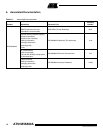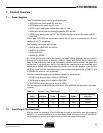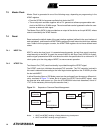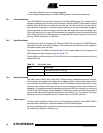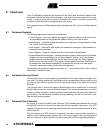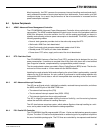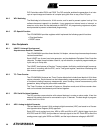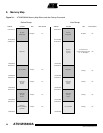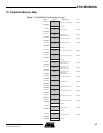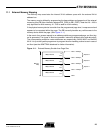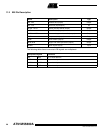
19
1745D–ATARM–04-Nov-05
AT91M55800A
Most importantly, the PDC removes the processor interrupt handling overhead and signifi-
cantly reduces the number of clock cycles required for a data transfer. It can transfer up to 64K
contiguous bytes. As a result, the performance of the microcontroller is increased and the
power consumption reduced.
8.4 System Peripherals
8.4.1 APMC: Advanced Power Management Controller
The AT91M55800A Advanced Power Management Controller allows optimization of power
consumption. The APMC enables/disables the clock inputs of most of the peripherals and the
ARM Core. Moreover, the main oscillator, the PLL and the analog peripherals can be put in
standby mode allowing minimum power consumption to be obtained. The APMC provides the
following operating modes:
• Normal: clock generator provides clock to the entire chip except the RTC.
• Wait mode: ARM Core clock deactivated
• Slow Clock mode: clock generator deactivated, master clock 32 kHz
• Standby mode: RTC active, all other clocks disabled
• Power down: RTC active, supply on the rest of the circuit deactivated
8.4.2 RTC: Real-time Clock
The AT91M55800A features a Real-time Clock (RTC) peripheral that is designed for very low
power consumption. It combines a complete time-of-day clock with alarm and a two-hundred
year Gregorian calendar, complemented by a programmable periodic interrupt.
The time and calendar values are coded in Binary-Coded Decimal (BCD) format. The time for-
mat can be 24-hour mode or 12-hour mode with an AM/PM indicator.
Updating time and calendar fields and configuring the alarm fields is performed by a parallel
capture on the 32-bit data bus. An entry control is performed to avoid loading registers with
incompatible BCD format data or with an incompatible date according to the current month/
year/century.
8.4.3 AIC: Advanced Interrupt Controller
The AIC has an 8-level priority, individually maskable, vectored interrupt controller, and drives
the NIRQ and NFIQ pins of the ARM7TDMI from:
• The external fast interrupt line (FIQ)
• The six external interrupt request lines (IRQ0 - IRQ5)
• The interrupt signals from the on-chip peripherals.
The AIC is largely programmable offering maximum flexibility, and its vectoring features
reduce the real-time overhead in handling interrupts.
The AIC also features a spurious vector, which reduces Spurious Interrupt handling to a mini-
mum, and a protect mode that facilitates the debug capabilities.
8.4.4 PIO: Parallel I/O Controller
The AT91M55800A has 58 programmable I/O lines. 13 pins are dedicated as general-purpose
I/O pins. The other I/O lines are multiplexed with an external signal of a peripheral to optimize
the use of available package pins. The PIO lines are controlled by two separate and identical




